SUBARU BRZ 2015 1.G Owners Manual
Manufacturer: SUBARU, Model Year: 2015, Model line: BRZ, Model: SUBARU BRZ 2015 1.GPages: 492, PDF Size: 6.53 MB
Page 171 of 492
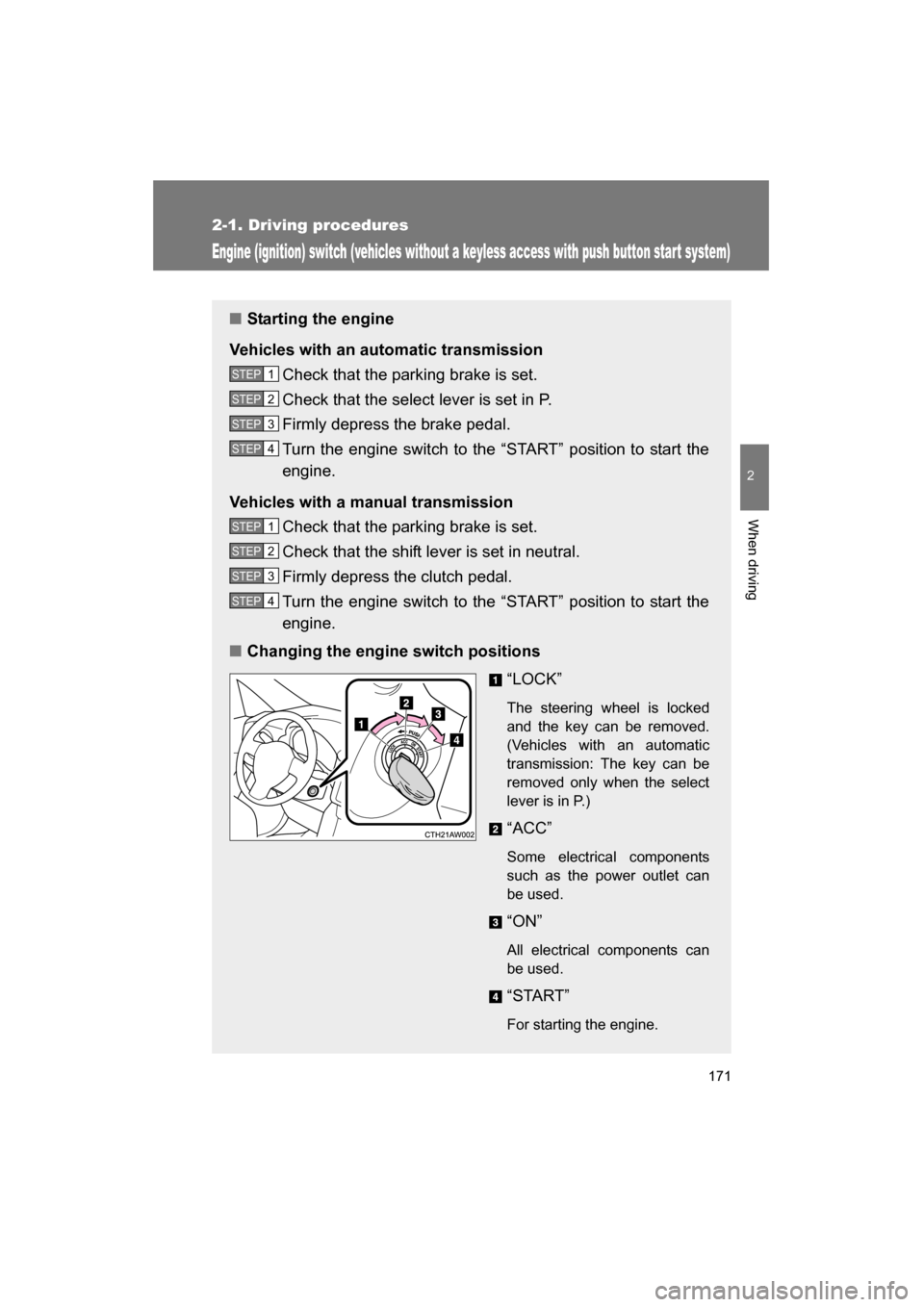
171
2-1. Driving procedures
2
When driving
Engine (ignition) switch (vehicles without a keyless access with push button start system)
■Starting the engine
Vehicles with an automatic transmission Check that the parking brake is set.
Check that the select lever is set in P.
Firmly depress the brake pedal.
Turn the engine switch to the “START” position to start the
engine.
Vehicles with a manual transmission Check that the parking brake is set.
Check that the shift lever is set in neutral.
Firmly depress the clutch pedal.
Turn the engine switch to the “START” position to start the
engine.
■Changing the engine switch positions
“LOCK”
The steering wheel is locked
and the key can be removed.
(Vehicles with an automatic
transmission: The key can be
removed only when the select
lever is in P.)
“ACC”
Some electrical components
such as the power outlet can
be used.
“ON”
All electrical components can
be used.
“START”
For starting the engine.
STEP 1
STEP 2
STEP 3
STEP 4
STEP 1
STEP 2
STEP 3
STEP 4
Page 172 of 492
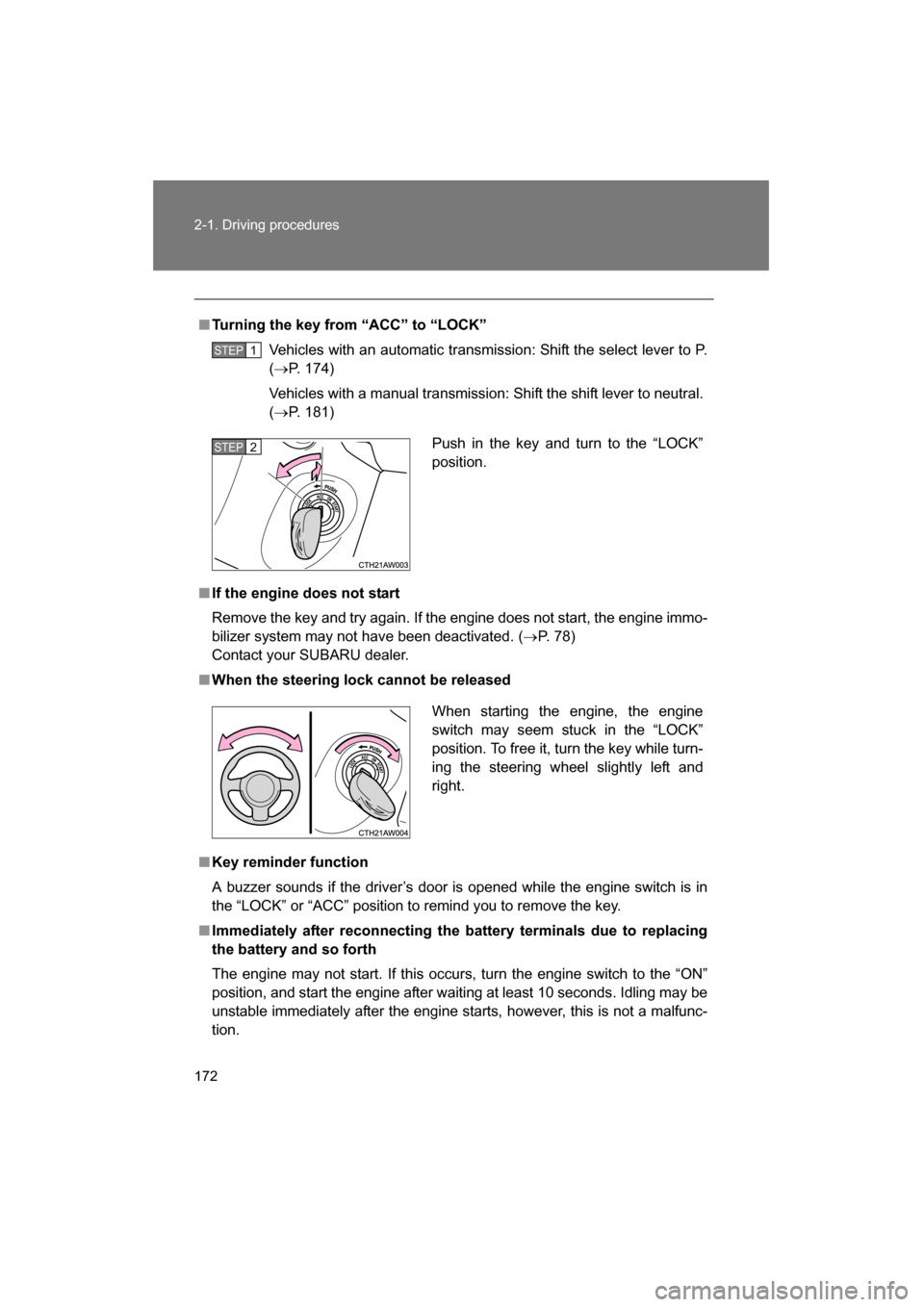
172
2-1. Driving procedures
■Turning the key from “ACC” to “LOCK”Vehicles with an automatic transmission: Shift the select lever to P. (→ P. 174)
Vehicles with a manual transmission: Shift the shift lever to neutral. ( → P. 181)
■If the engine does not start
Remove the key and try again. If the engine does not start, the engine immo-
bilizer system may not have been deactivated. ( →P. 78)
Contact your SUBARU dealer.
■When the steering lock cannot be released
■Key reminder function
A buzzer sounds if the driver’s door is opened while the engine switch is in
the “LOCK” or “ACC” position to remind you to remove the key.
■Immediately after reconnecting the battery terminals due to replacing
the battery and so forth
The engine may not start. If this occurs, turn the engine switch to the “ON”
position, and start the engine after waiting at least 10 seconds. Idling may be
unstable immediately after the engine starts, however, this is not a malfunc-
tion.
STEP 1
Push in the key and turn to the “LOCK”
position.STEP 2
When starting the engine, the engine
switch may seem stuck in the “LOCK”
position. To free it, turn the key while turn-
ing the steering wheel slightly left andright.
Page 173 of 492
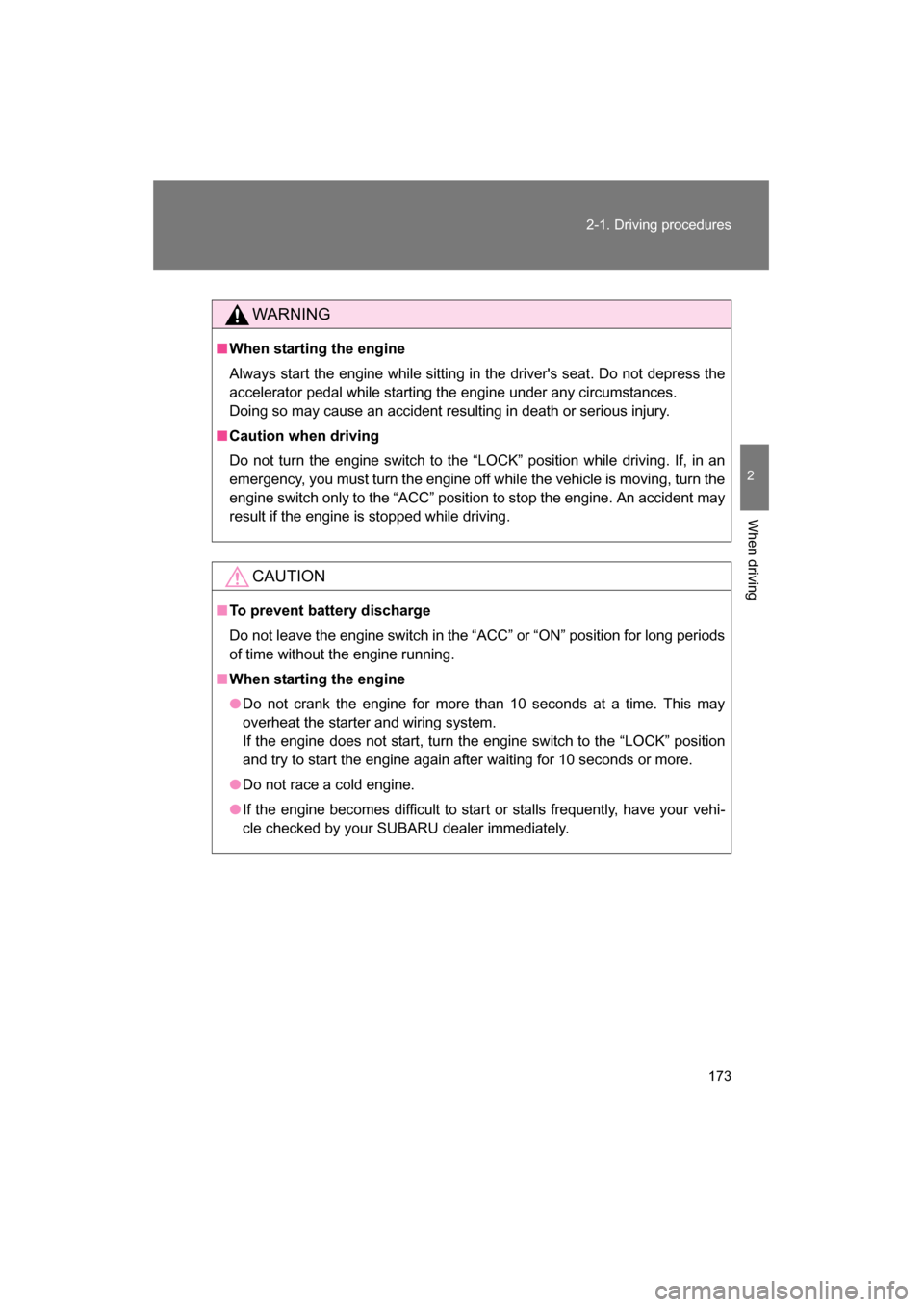
173
2-1. Driving procedures
2
When driving
WARNING
■When starting the engine
Always start the engine while sitting in the driver's seat. Do not depress the
accelerator pedal while starting the engine under any circumstances.
Doing so may cause an accident resulting in death or serious injury.
■Caution when driving
Do not turn the engine switch to the “LOCK” position while driving. If, in an
emergency, you must turn the engine off while the vehicle is moving, turn the
engine switch only to the “ACC” position to stop the engine. An accident may
result if the engine is stopped while driving.
CAUTION
■To prevent battery discharge
Do not leave the engine switch in the “ACC” or “ON” position for long periods
of time without the engine running.
■When starting the engine
●Do not crank the engine for more than 10 seconds at a time. This may
overheat the starter and wiring system.
If the engine does not start, turn the engine switch to the “LOCK” position
and try to start the engine again after waiting for 10 seconds or more.
●Do not race a cold engine.
●If the engine becomes difficult to start or stalls frequently, have your vehi-
cle checked by your SUBARU dealer immediately.
Page 174 of 492
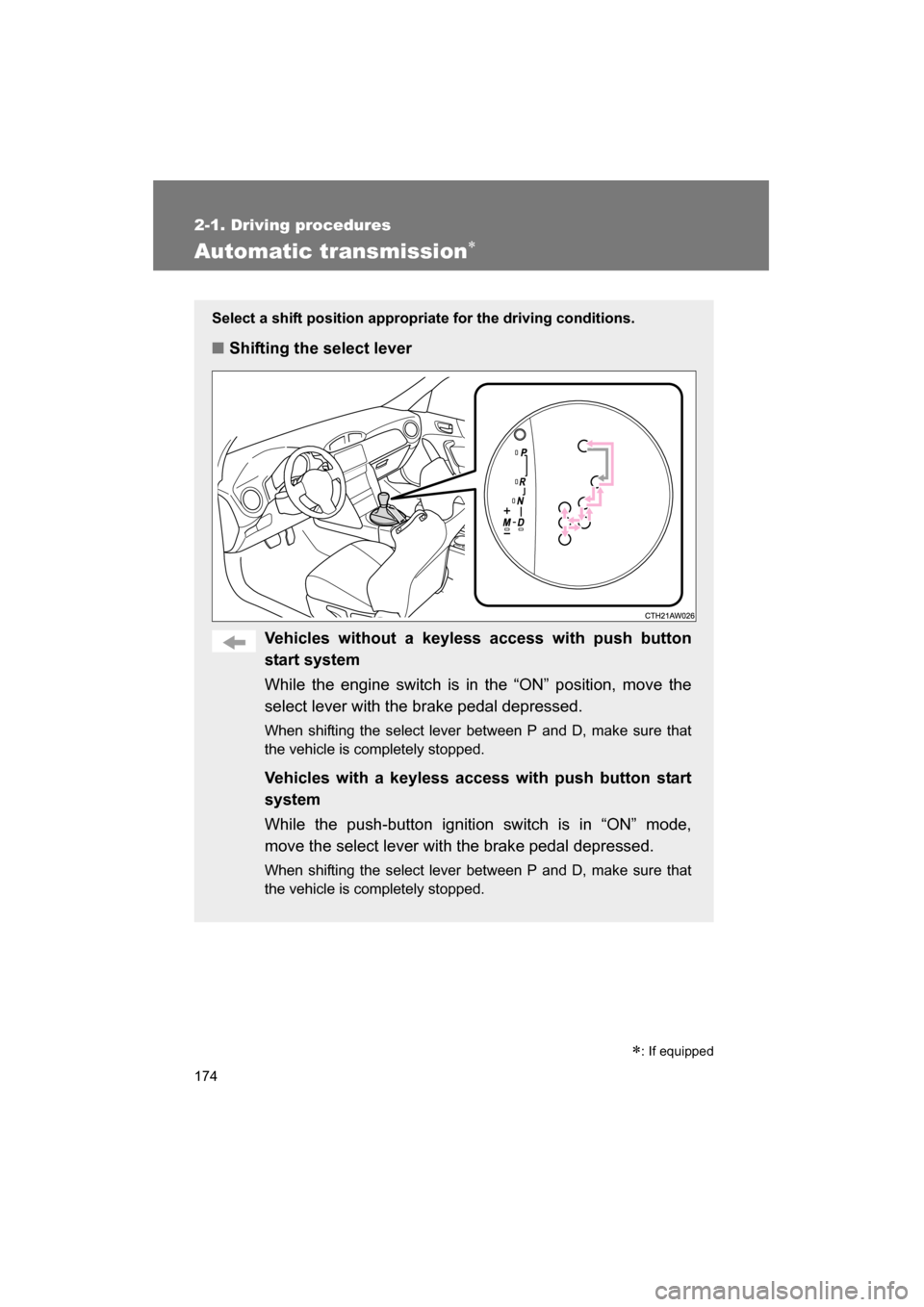
174
2-1. Driving procedures
Automatic transmission∗
Select a shift position appropriate for the driving conditions.
■Shifting the select lever
Vehicles without a keyless access with push button
start system
While the engine switch is in the “ON” position, move the
select lever with the brake pedal depressed.
When shifting the select lever between P and D, make sure that
the vehicle is completely stopped.
Vehicles with a keyless access with push button start
system
While the push-button ignition switch is in “ON” mode,
move the select lever with the brake pedal depressed.
When shifting the select lever between P and D, make sure that
the vehicle is completely stopped.
∗: If equipped
Page 175 of 492
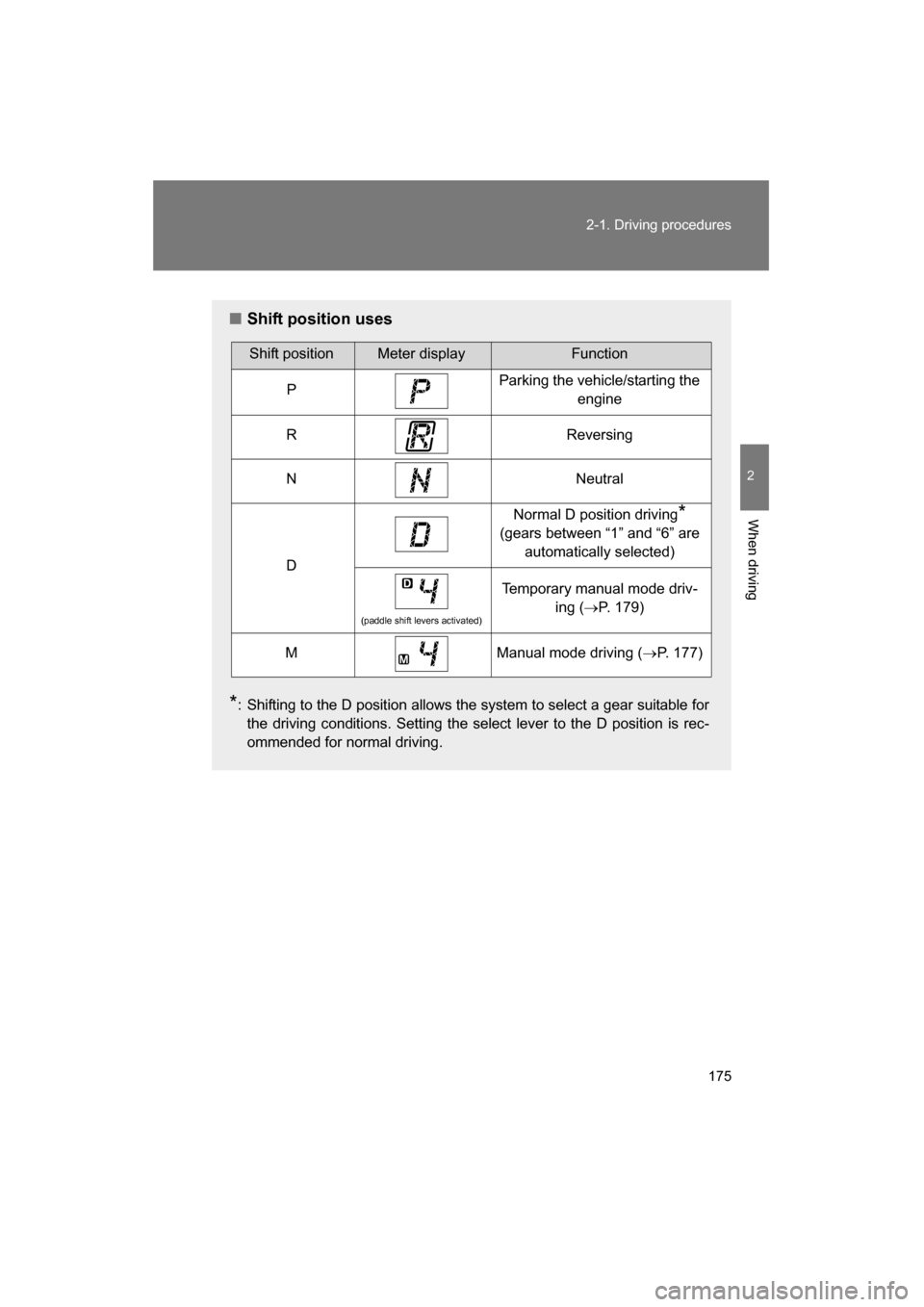
175
2-1. Driving procedures
2
When driving
■Shift position uses
* : Shifting to the D position allows the system to select a gear suitable for
the driving conditions. Setting the select lever to the D position is rec-
ommended for normal driving.
Shift positionMeter displayFunction
PParking the vehicle/starting the engine
RReversing
NNeutral
D
Normal D position driving *
(gears between “1” and “6” are automatically selected)
(paddle shift levers activated)
Temporary manual mode driv- ing (→P. 179)
MManual mode driving ( →P. 177)
Page 176 of 492
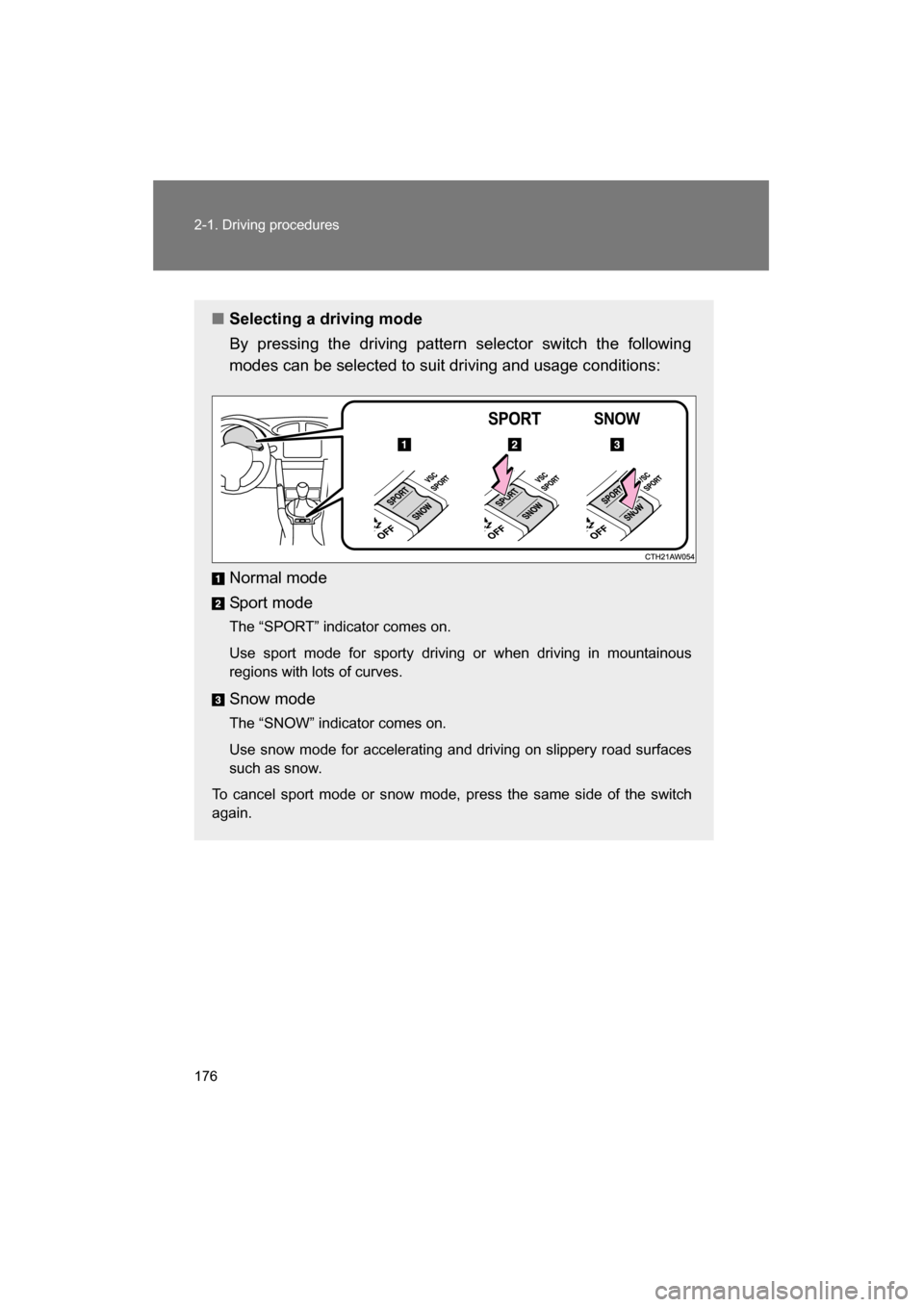
176
2-1. Driving procedures
■Selecting a driving mode
By pressing the driving pattern selector switch the following
modes can be selected to suit driving and usage conditions:
Normal mode
Sport mode
The “SPORT” indicator comes on.
Use sport mode for sporty driving or when driving in mountainous
regions with lots of curves.
Snow mode
The “SNOW” indicator comes on.
Use snow mode for accelerating and driving on slippery road surfaces
such as snow.
To cancel sport mode or snow mode, press the same side of the switchagain.
Page 177 of 492
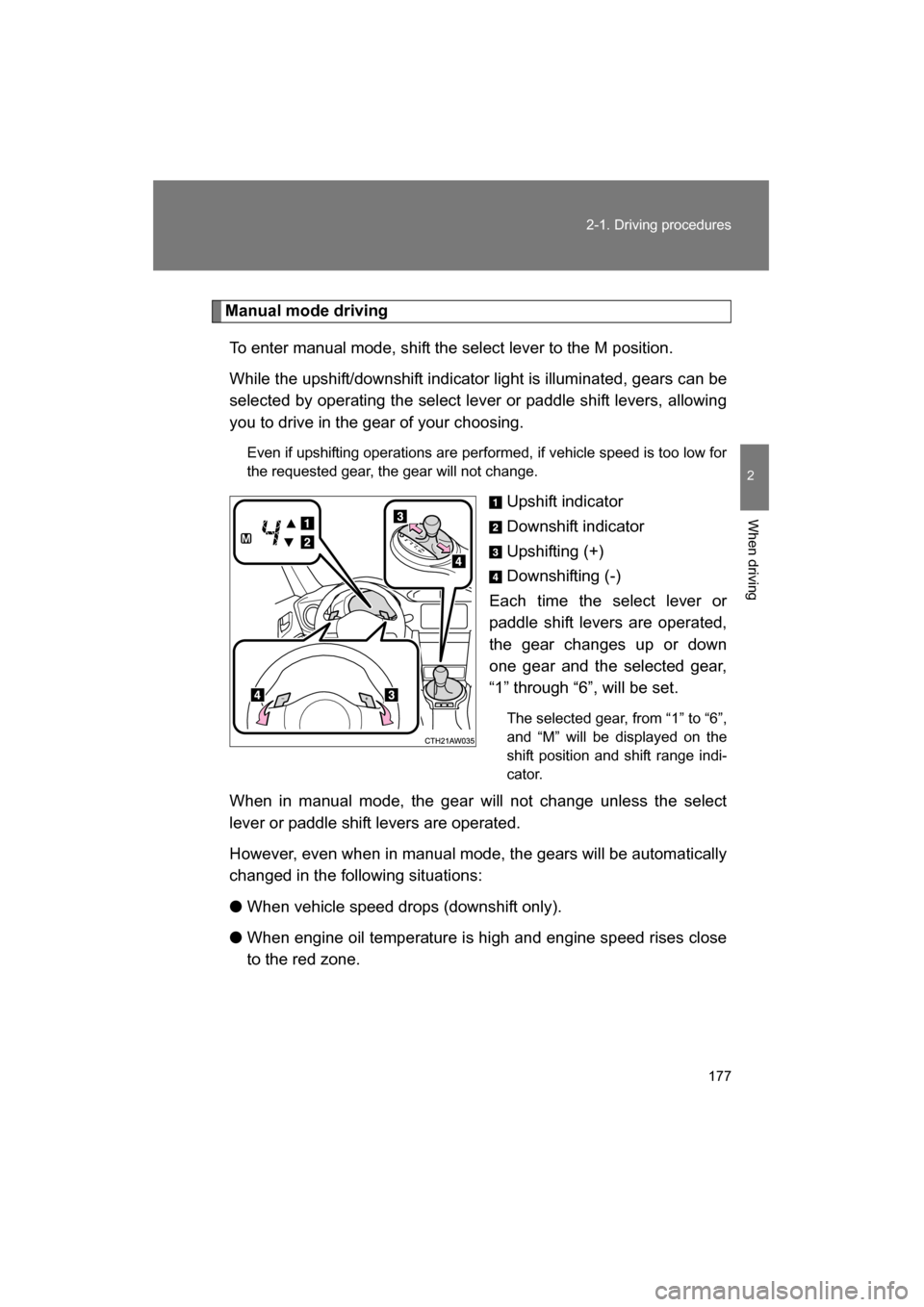
177
2-1. Driving procedures
2
When driving
Manual mode drivingTo enter manual mode, shift the select lever to the M position.
While the upshift/downshift indicator light is illuminated, gears can be
selected by operating the select lever or paddle shift levers, allowing
you to drive in the gear of your choosing. Even if upshifting operations are performed, if vehicle speed is too low for
the requested gear, the gear will not change.
Upshift indicator
Downshift indicator
Upshifting (+)
Downshifting (-)
Each time the select lever or
paddle shift levers are operated,
the gear changes up or down
one gear and the selected gear,
“1” through “6”, will be set.
The selected gear, from “1” to “6”,
and “M” will be displayed on the
shift position and shift range indi-
cator.
When in manual mode, the gear will not change unless the select
lever or paddle shift levers are operated.
However, even when in manual mode, the gears will be automatically
changed in the following situations: ● When vehicle speed drops (downshift only).
● When engine oil temperature is high and engine speed rises close
to the red zone.
Page 178 of 492
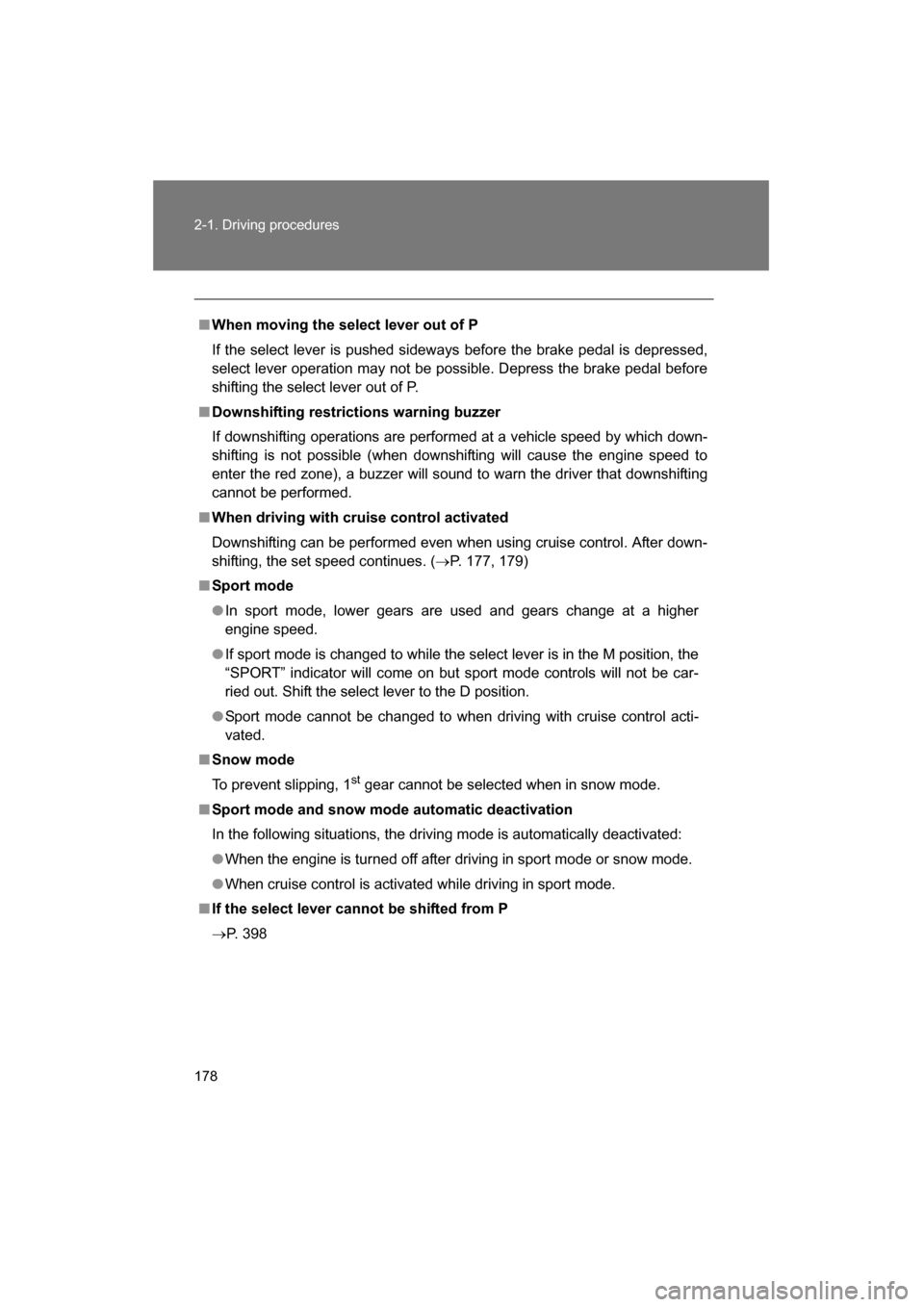
178
2-1. Driving procedures
■When moving the select lever out of P
If the select lever is pushed sideways before the brake pedal is depressed,
select lever operation may not be possible. Depress the brake pedal before
shifting the select lever out of P.
■Downshifting restrictions warning buzzer
If downshifting operations are performed at a vehicle speed by which down-
shifting is not possible (when downshifting will cause the engine speed to
enter the red zone), a buzzer will sound to warn the driver that downshifting
cannot be performed.
■When driving with cruise control activated
Downshifting can be performed even when using cruise control. After down-
shifting, the set speed continues. (→P. 177, 179)
■Sport mode
●In sport mode, lower gears are used and gears change at a higher
engine speed.
●If sport mode is changed to while the select lever is in the M position, the
“SPORT” indicator will come on but sport mode controls will not be car-
ried out. Shift the select lever to the D position.
●Sport mode cannot be changed to when driving with cruise control acti-
vated.
■Snow mode
To prevent slipping, 1 st
gear cannot be selected when in snow mode.
■Sport mode and snow mode automatic deactivation
In the following situations, the driving mode is automatically deactivated:
●When the engine is turned off after dr iving in sport mode or snow mode.
●When cruise control is activated while driving in sport mode.
■If the select lever cannot be shifted from P
→P. 398
Page 179 of 492
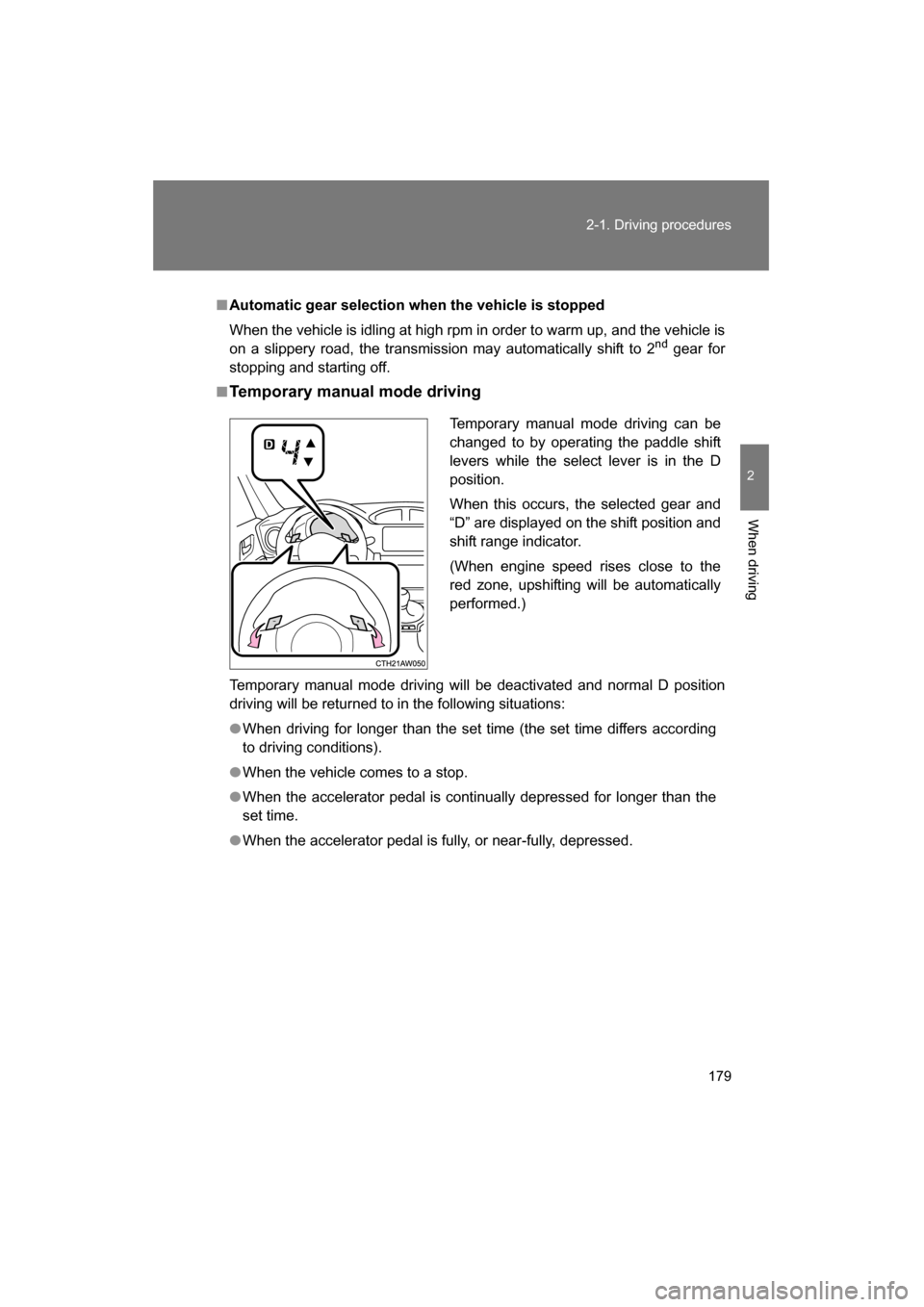
179
2-1. Driving procedures
2
When driving
■Automatic gear selection when the vehicle is stopped
When the vehicle is idling at high rpm in order to warm up, and the vehicle is
on a slippery road, the transmission may automatically shift to 2nd
gear for
stopping and starting off.
■Temporary manual mode driving
Temporary manual mode driving will be deactivated and normal D position
driving will be returned to in the following situations:
●When driving for longer than the set time (the set time differs according
to driving conditions).
●When the vehicle comes to a stop.
●When the accelerator pedal is continually depressed for longer than the
set time.
●When the accelerator pedal is fully, or near-fully, depressed. Temporary manual mode driving can be
changed to by operating the paddle shift
levers while the select lever is in the D
position.
When this occurs, the selected gear and
“D” are displayed on the shift position and
shift range indicator.
(When engine speed rises close to the
red zone, upshifting will be automaticallyperformed.)
Page 180 of 492
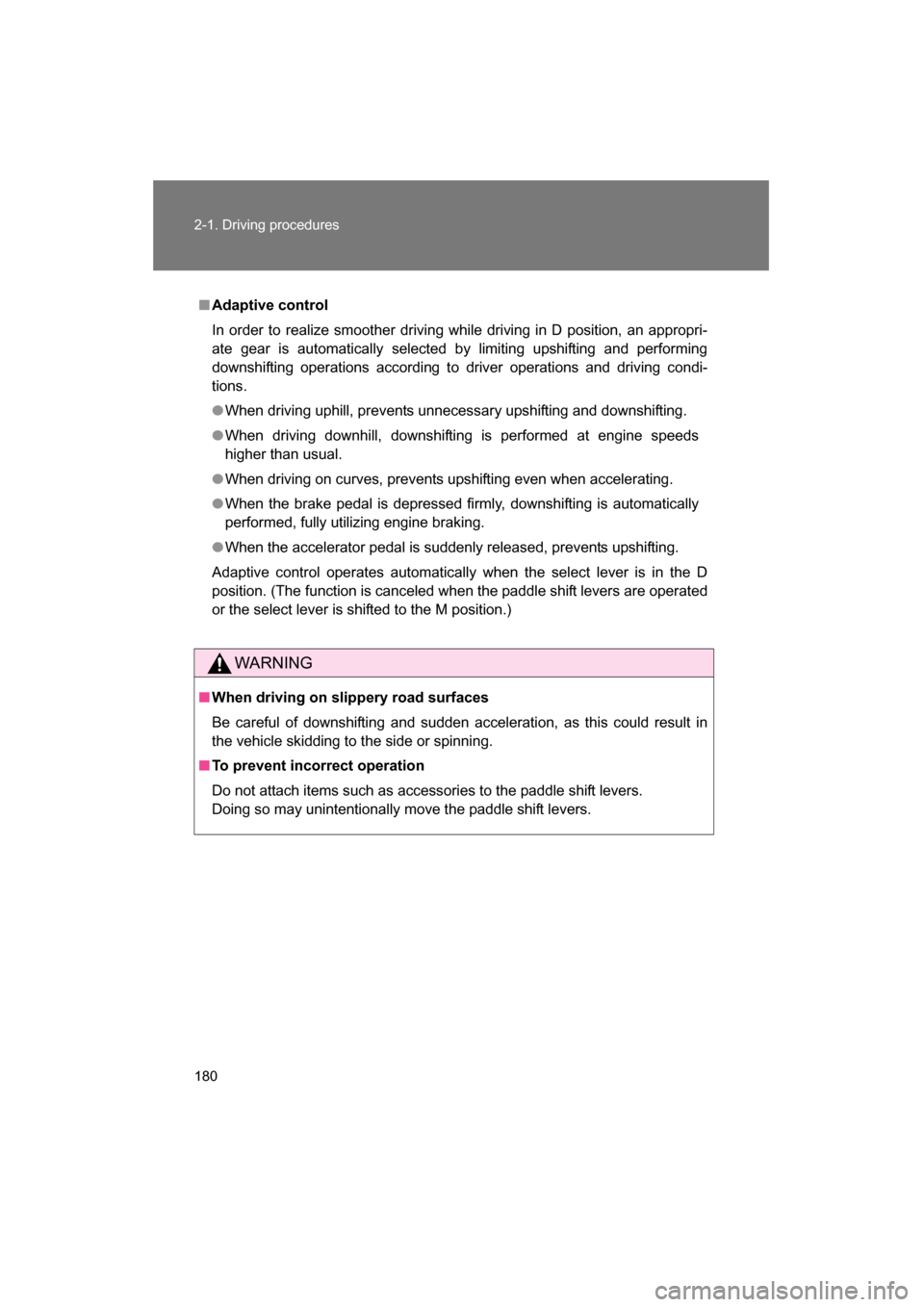
180
2-1. Driving procedures
■Adaptive control
In order to realize smoother driving while driving in D position, an appropri-
ate gear is automatically selected by limiting upshifting and performing
downshifting operations according to driver operations and driving condi-
tions.
●When driving uphill, prevents unnecessary upshifting and downshifting.
●When driving downhill, downshift ing is performed at engine speeds
higher than usual.
●When driving on curves, prevents upshifting even when accelerating.
●When the brake pedal is depressed firmly, downshifting is automatically
performed, fully utilizing engine braking.
●When the accelerator pedal is suddenly released, prevents upshifting.
Adaptive control operates automatically when the select lever is in the D
position. (The function is canceled when the paddle shift levers are operated
or the select lever is shifted to the M position.)
WARNING
■When driving on slippery road surfaces
Be careful of downshifting and sudden acceleration, as this could result in
the vehicle skidding to the side or spinning.
■To prevent incorrect operation
Do not attach items such as accessories to the paddle shift levers.
Doing so may unintentionally move the paddle shift levers.